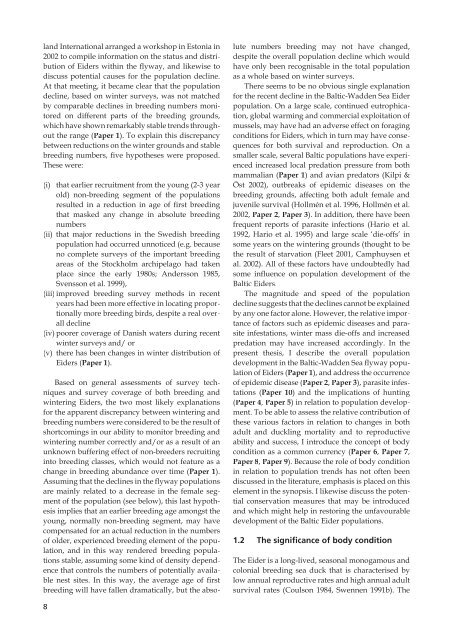Factors affecting population size of Baltic Common Eiders Somateria ...
Factors affecting population size of Baltic Common Eiders Somateria ...
Factors affecting population size of Baltic Common Eiders Somateria ...
Create successful ePaper yourself
Turn your PDF publications into a flip-book with our unique Google optimized e-Paper software.
land International arranged a workshop in Estonia in<br />
2002 to compile information on the status and distribution<br />
<strong>of</strong> <strong>Eiders</strong> within the flyway, and likewise to<br />
discuss potential causes for the <strong>population</strong> decline.<br />
At that meeting, it became clear that the <strong>population</strong><br />
decline, based on winter surveys, was not matched<br />
by comparable declines in breeding numbers monitored<br />
on different parts <strong>of</strong> the breeding grounds,<br />
which have shown remarkably stable trends throughout<br />
the range (Paper 1). To explain this discrepancy<br />
between reductions on the winter grounds and stable<br />
breeding numbers, five hypotheses were proposed.<br />
These were:<br />
(i) that earlier recruitment from the young (2-3 year<br />
old) non-breeding segment <strong>of</strong> the <strong>population</strong>s<br />
resulted in a reduction in age <strong>of</strong> first breeding<br />
that masked any change in absolute breeding<br />
numbers<br />
(ii) that major reductions in the Swedish breeding<br />
<strong>population</strong> had occurred unnoticed (e.g. because<br />
no complete surveys <strong>of</strong> the important breeding<br />
areas <strong>of</strong> the Stockholm archipelago had taken<br />
place since the early 1980s; Andersson 1985,<br />
Svensson et al. 1999),<br />
(iii) improved breeding survey methods in recent<br />
years had been more effective in locating proportionally<br />
more breeding birds, despite a real overall<br />
decline<br />
(iv) poorer coverage <strong>of</strong> Danish waters during recent<br />
winter surveys and/ or<br />
(v) there has been changes in winter distribution <strong>of</strong><br />
<strong>Eiders</strong> (Paper 1).<br />
Based on general assessments <strong>of</strong> survey techniques<br />
and survey coverage <strong>of</strong> both breeding and<br />
wintering <strong>Eiders</strong>, the two most likely explanations<br />
for the apparent discrepancy between wintering and<br />
breeding numbers were considered to be the result <strong>of</strong><br />
shortcomings in our ability to monitor breeding and<br />
wintering number correctly and/or as a result <strong>of</strong> an<br />
unknown buffering effect <strong>of</strong> non-breeders recruiting<br />
into breeding classes, which would not feature as a<br />
change in breeding abundance over time (Paper 1).<br />
Assuming that the declines in the flyway <strong>population</strong>s<br />
are mainly related to a decrease in the female segment<br />
<strong>of</strong> the <strong>population</strong> (see below), this last hypothesis<br />
implies that an earlier breeding age amongst the<br />
young, normally non-breeding segment, may have<br />
compensated for an actual reduction in the numbers<br />
<strong>of</strong> older, experienced breeding element <strong>of</strong> the <strong>population</strong>,<br />
and in this way rendered breeding <strong>population</strong>s<br />
stable, assuming some kind <strong>of</strong> density dependence<br />
that controls the numbers <strong>of</strong> potentially available<br />
nest sites. In this way, the average age <strong>of</strong> first<br />
breeding will have fallen dramatically, but the abso-<br />
8<br />
lute numbers breeding may not have changed,<br />
despite the overall <strong>population</strong> decline which would<br />
have only been recognisable in the total <strong>population</strong><br />
as a whole based on winter surveys.<br />
There seems to be no obvious single explanation<br />
for the recent decline in the <strong>Baltic</strong>-Wadden Sea Eider<br />
<strong>population</strong>. On a large scale, continued eutrophication,<br />
global warming and commercial exploitation <strong>of</strong><br />
mussels, may have had an adverse effect on foraging<br />
conditions for <strong>Eiders</strong>, which in turn may have consequences<br />
for both survival and reproduction. On a<br />
smaller scale, several <strong>Baltic</strong> <strong>population</strong>s have experienced<br />
increased local predation pressure from both<br />
mammalian (Paper 1) and avian predators (Kilpi &<br />
Öst 2002), outbreaks <strong>of</strong> epidemic diseases on the<br />
breeding grounds, <strong>affecting</strong> both adult female and<br />
juvenile survival (Hollmén et al. 1996, Hollmén et al.<br />
2002, Paper 2, Paper 3). In addition, there have been<br />
frequent reports <strong>of</strong> parasite infections (Hario et al.<br />
1992, Hario et al. 1995) and large scale ‘die-<strong>of</strong>fs’ in<br />
some years on the wintering grounds (thought to be<br />
the result <strong>of</strong> starvation (Fleet 2001, Camphuysen et<br />
al. 2002). All <strong>of</strong> these factors have undoubtedly had<br />
some influence on <strong>population</strong> development <strong>of</strong> the<br />
<strong>Baltic</strong> <strong>Eiders</strong>.<br />
The magnitude and speed <strong>of</strong> the <strong>population</strong><br />
decline suggests that the declines cannot be explained<br />
by any one factor alone. However, the relative importance<br />
<strong>of</strong> factors such as epidemic diseases and parasite<br />
infestations, winter mass die-<strong>of</strong>fs and increased<br />
predation may have increased accordingly. In the<br />
present thesis, I describe the overall <strong>population</strong><br />
development in the <strong>Baltic</strong>-Wadden Sea flyway <strong>population</strong><br />
<strong>of</strong> <strong>Eiders</strong> (Paper 1), and address the occurrence<br />
<strong>of</strong> epidemic disease (Paper 2, Paper 3), parasite infestations<br />
(Paper 10) and the implications <strong>of</strong> hunting<br />
(Paper 4, Paper 5) in relation to <strong>population</strong> development.<br />
To be able to assess the relative contribution <strong>of</strong><br />
these various factors in relation to changes in both<br />
adult and duckling mortality and to reproductive<br />
ability and success, I introduce the concept <strong>of</strong> body<br />
condition as a common currency (Paper 6, Paper 7,<br />
Paper 8, Paper 9). Because the role <strong>of</strong> body condition<br />
in relation to <strong>population</strong> trends has not <strong>of</strong>ten been<br />
discussed in the literature, emphasis is placed on this<br />
element in the synopsis. I likewise discuss the potential<br />
conservation measures that may be introduced<br />
and which might help in restoring the unfavourable<br />
development <strong>of</strong> the <strong>Baltic</strong> Eider <strong>population</strong>s.<br />
1.2 The significance <strong>of</strong> body condition<br />
The Eider is a long-lived, seasonal monogamous and<br />
colonial breeding sea duck that is characterised by<br />
low annual reproductive rates and high annual adult<br />
survival rates (Coulson 1984, Swennen 1991b). The

















